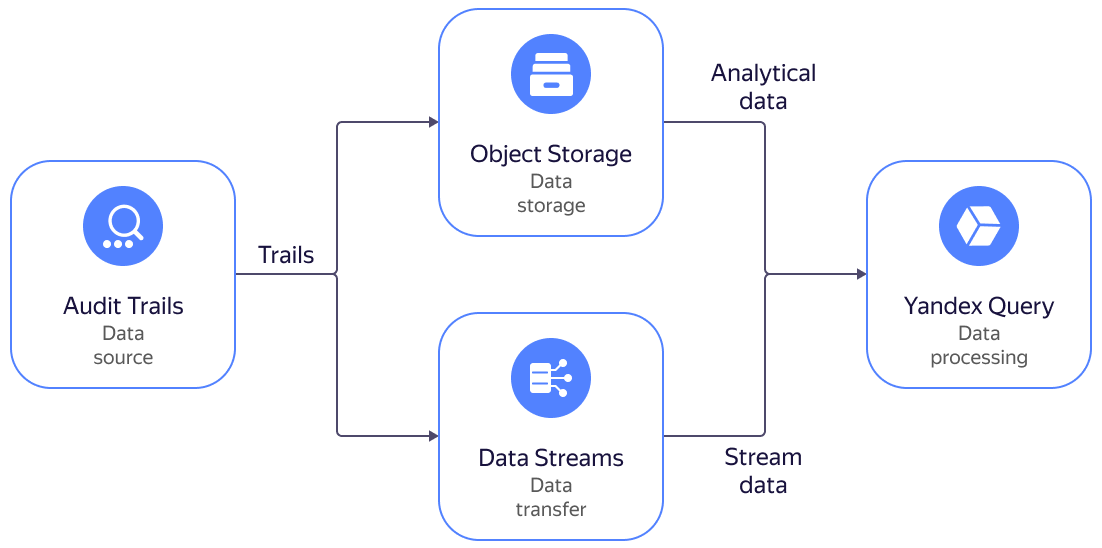Configuring Yandex Query
Audit Trails support is integrated in Yandex Query. You can analyze events of Yandex Cloud resources by executing analytical and streaming YQL queries.
You can execute analytical queries for logs stored in a bucket and streaming queries for logs stored in a Yandex Data Streams data stream.

To connect a bucket with audit logs to Yandex Query and execute YQL queries:
- Set up your environment.
- Create a connection between a trail and YQ.
- Execute a query to logs in Object Storage.
If you no longer need the resources you created, delete them.
Getting started
Sign up in Yandex Cloud and create a billing account:
- Navigate to the management console
- On the Yandex Cloud Billing
ACTIVEorTRIAL_ACTIVEstatus. If you do not have a billing account, create one and link a cloud to it.
If you have an active billing account, you can navigate to the cloud page
Learn more about clouds and folders.
If you do not have the Yandex Cloud CLI yet, install and initialize it.
Required paid resources
The cost of infrastructure support includes a fee for a bucket (see Pricing for Object Storage).
Set up your environment
Create a bucket for audit logs
- In the management console
example-folder. - Select Object Storage.
- Click Create bucket.
- On the bucket creation page:
- Enter a name for the bucket according to the naming requirements.
- In the Object read access, Object listing access, and Read access to settings fields, select
Restricted. - Leave other parameters at their defaults.
- Click Create bucket.
Create service accounts
Create the trail-sa service account:
- In the management console
example-folder. - From the list of services, select Identity and Access Management.
- Click Create service account.
- Specify Name:
trail-sa. - Click Create.
Similarly, create a service account named bucket-yq-sa.
Assign permissions to service accounts
Assign the audit-trails.viewer and storage.uploader roles to the trail-sa service account:
-
The
audit-trails.viewerrole for an organization:yc organization-manager organization add-access-binding \ --role audit-trails.viewer \ --id <organization_ID> \ --service-account-id <service_account_ID>Where
--service-account-idis thetrail-saservice account ID.Result:
done (1s)For more information about the
yc organization-manager organization add-access-bindingcommand, see the CLI reference. -
The
storage.uploaderrole for a folder:yc resource-manager folder add-access-binding example-folder \ --role storage.uploader \ --subject serviceAccount:<service_account_ID>Where
--subjectis thetrail-saservice account ID.Result:
done (1s)For more information about the
yc resource-manager folder add-access-bindingcommand, see the CLI reference.
Assign the bucket-yq-sa service account the storage.viewer role for example-folder:
yc resource-manager folder add-access-binding example-folder \
--role storage.viewer \
--subject serviceAccount:<service_account_ID>
Where --subject is the bucket-yq-sa service account ID.
Result:
done (1s)
For more information about the yc resource-manager folder add-access-binding command, see the CLI reference.
Create a trail
-
In the management console
example-folder. -
Select Audit Trails.
-
Click Create trail.
-
In the Name field, specify
logsyq. -
Under Destination, configure the destination object:
- Destination:
Object Storage. - Bucket: Select the bucket you created earlier.
- Destination:
-
Under Service account, select
trail-sa. -
Under Collecting management events, configure the collection of management event audit logs:
- Collecting events: Select
Enabled. - Resource: Select
Organization. - Organization: Automatically populated field containing the name of the current organization.
- Cloud: Keep the default value,
All.
- Collecting events: Select
-
Under Collecting data events, select
Disabledin the Collecting events field. -
Click Create.
Create a connection between a trail and YQ
A connection must be created only the first time a trail is connected to YQ.
- In the management console
example-folder. - Select Audit Trails.
- Select the
logsyqtrail. - Click Process in YQ.
- Create a connection.
- Select the
bucket-yq-saService account. - Leave other parameters at their defaults.
- Select the
- Click Create.
- In the window with data binding options, click Create.
You will go to the page for creating a query to trail logs.
Execute a query to logs in Object Storage
Open the page to create an analytical query to Audit Trails logs:
- In the management console
- From the list of services, select Audit Trails.
- Select the trail for which a connection to YQ is configured.
- Click Process in YQ to go to the analytical query execution page.
Run event queries to bind audit-trails-logsyq-object_storage:
-
Deleting a folder:
-
Select this query from the list: 1. Find out who deleted the folder.
-
Edit the query by specifying the folder ID:
SELECT * FROM bindings.`audit-trails-logsyq-object_storage` WHERE JSON_VALUE(data, "$.event_type") = 'yandex.cloud.audit.resourcemanager.DeleteFolder' and JSON_VALUE(data, "$.details.folder_name") = '<folder_ID>' LIMIT 100; -
Click Execute.
-
-
Enabling access via the serial console:
-
Select this query from the list: 6. Changing a VM: Adding serial console access.
-
Edit the query by specifying the number of displayed records:
SELECT * FROM bindings.`<audit-trails-logsyq-object_storage>` WHERE JSON_VALUE(data, "$.event_type") = 'yandex.cloud.audit.compute.UpdateInstance' and JSON_VALUE(data, "$.details.metadata_serial_port_enable") = '1' LIMIT <number_of_records>; -
Click Execute.
-
-
Changing access permissions for an Object Storage bucket:
-
Select this query from the list: 11. Suspicious activity with the Audit Trails log repository (Object Storage bucket).
-
Edit the query by specifying the number of displayed records:
SELECT * FROM bindings.`audit-trails-logsyq-object_storage` WHERE (JSON_VALUE(data, "$.event_type") = 'yandex.cloud.audit.storage.BucketAclUpdate' or JSON_VALUE(data, "$.event_type") = 'yandex.cloud.audit.storage.BucketPolicyUpdate') LIMIT <number_of_records>; -
Click Execute.
-
-
Assigning administrator permissions:
-
Select this query from the list: 20. Assigning admin permissions (for a folder and cloud).
-
Edit the query by specifying the number of displayed records:
SELECT * FROM bindings.`audit-trails-logsyq-object_storage` WHERE JSON_VALUE(data, "$.details.access_binding_deltas.access_binding.role_id") = 'admin' LIMIT <number_of_records>; -
Click Execute.
-
How to delete the resources you created
If you created a separate bucket to follow these instructions, you can delete it to stop paying for bucket use.